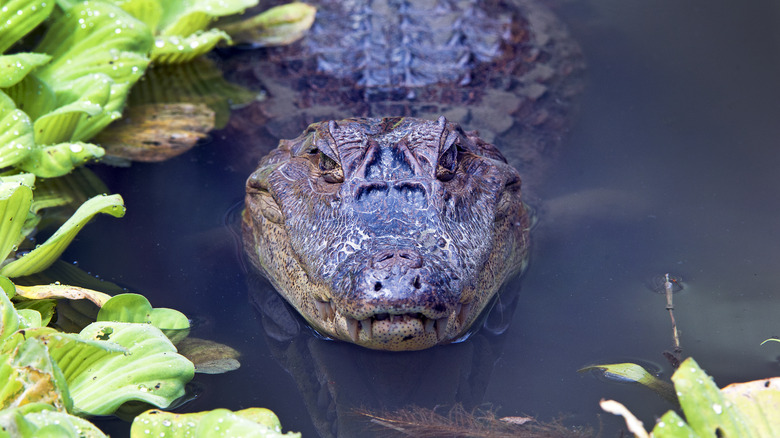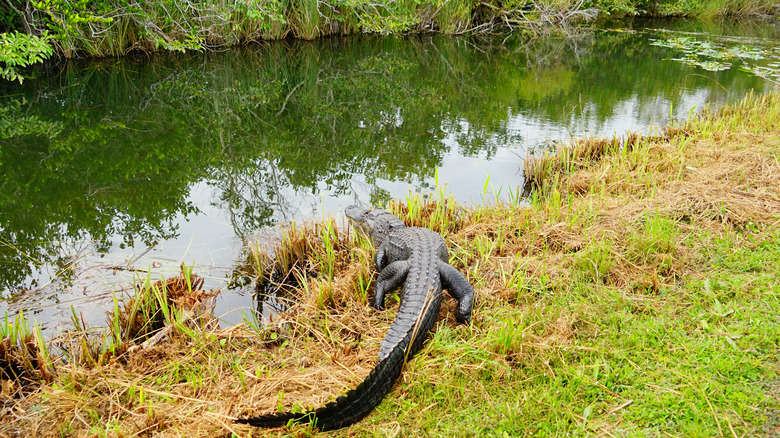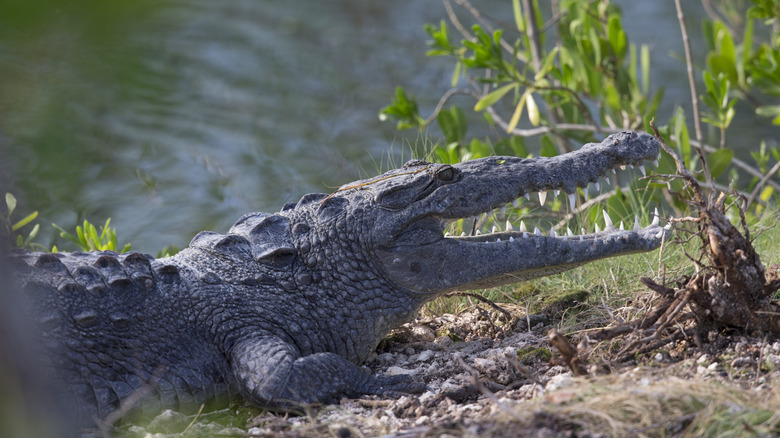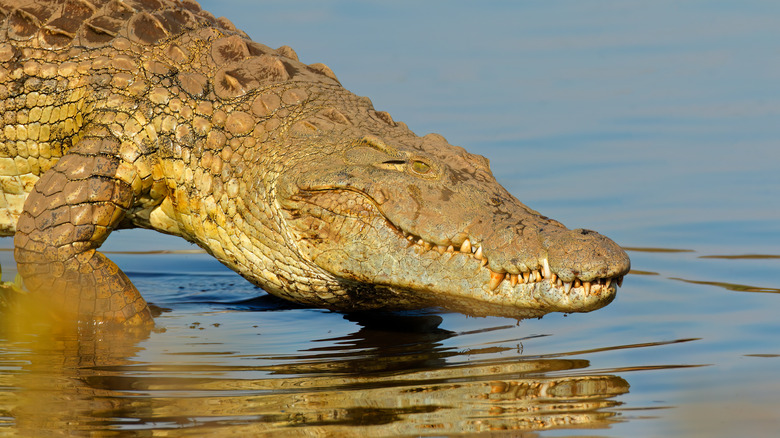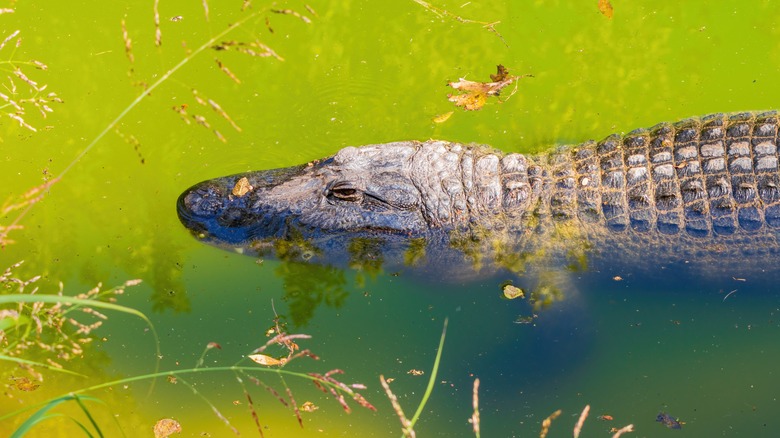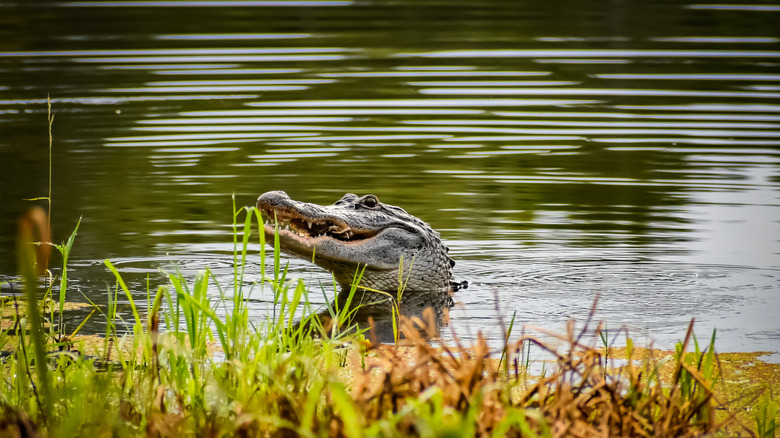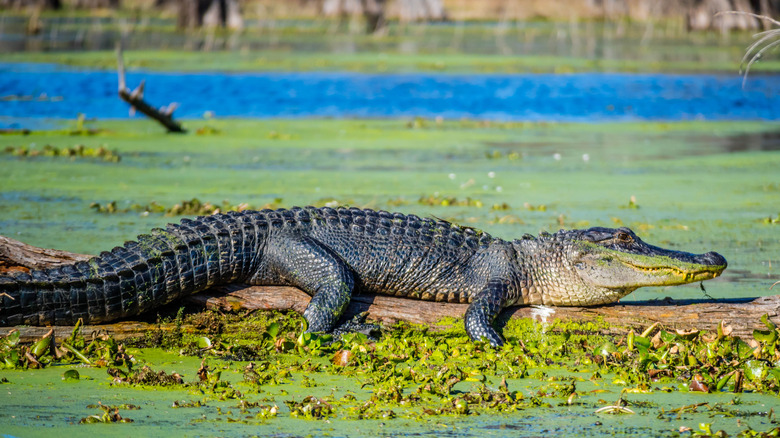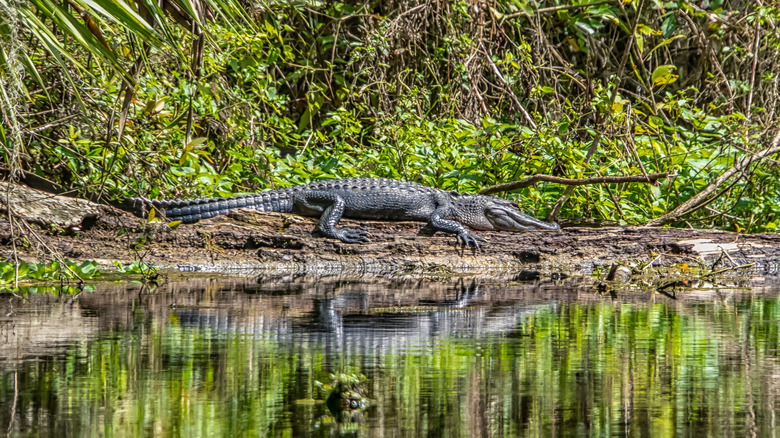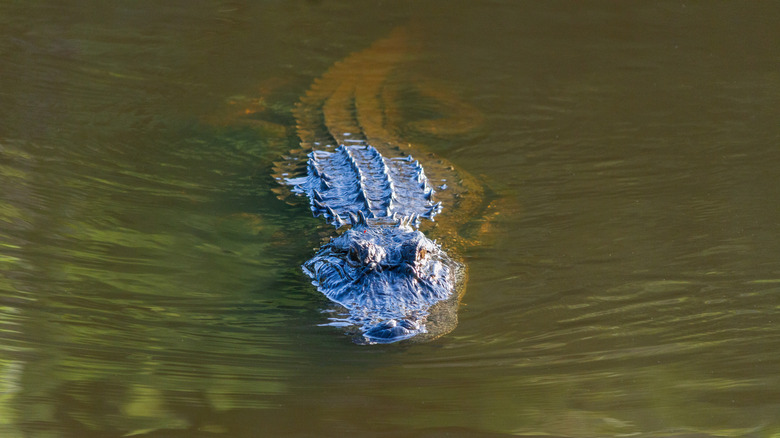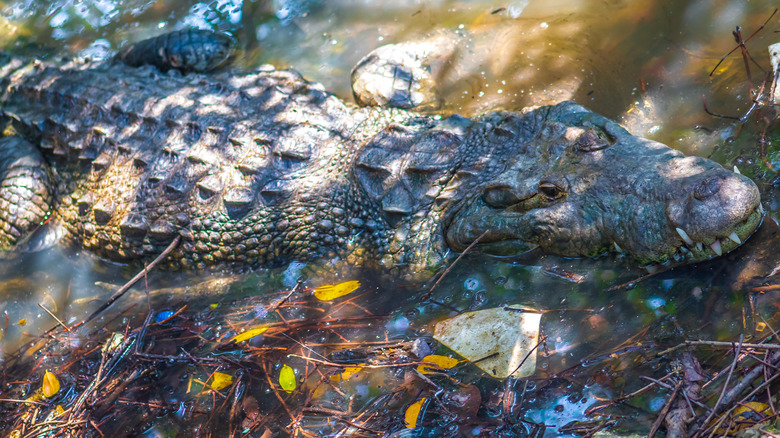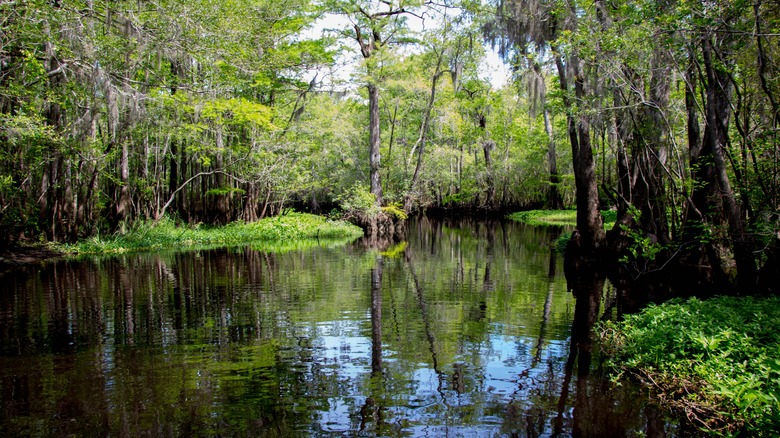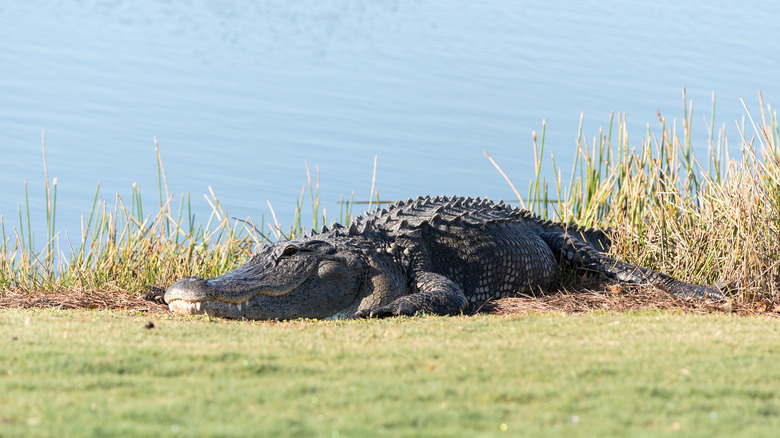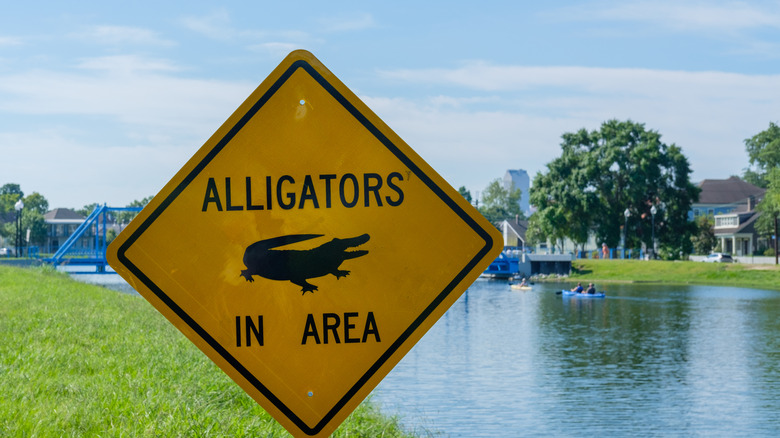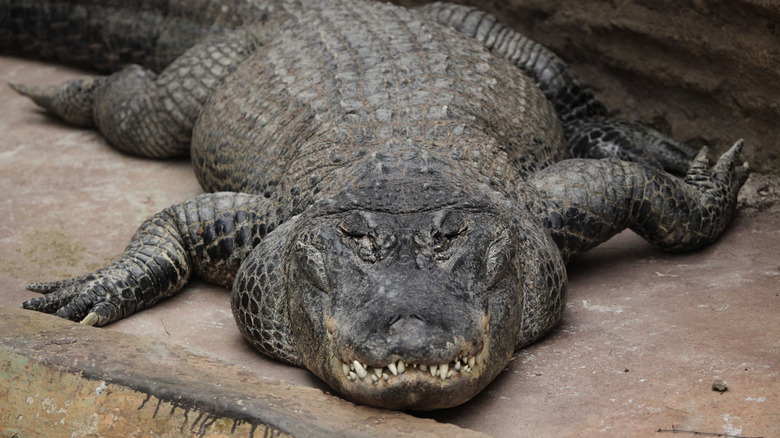Most Dangerous Gator And Crocodile-Infested Waters In The US
Hungry and fierce creatures have lurked in aquatic depths since complex life began on this planet. While few creatures are capable of turning a man into a meal in the United States, these ancient reptiles, armored from snout to tail, with jaws capable of crushing bones and teeth designed for tearing flesh, are among these few creatures. And while it may surprise some, alligators and crocodiles are more widespread in the U.S. than many believe. Crocodilians inhabit waters in the warm southern regions of the country. The American alligator belongs to territories ranging from Texas to the Carolinas and has a living population numbering in the millions. American crocodiles are less common, with a population of around 2,000 crocs living solely in South Florida and the Florida Keys.
You can most easily distinguish a gator by its rounded snout or a croc by its V-shaped muzzle. There are differences in color and temperament as well, as American crocodiles tend to be more aggressive. However, you probably won't care about differences or similarities when you see their ancient eyes break the water's surface of your favorite swimming hole. If this is a scenario you'd rather avoid, you may want to stay dry around these alligator and crocodile-infested waters in the U.S.
Double trouble in the South Florida canals
Messing around in the canals of South Florida could bring you face-to-face with both alligators and crocodiles. Alligators have historically made their homes in the swamps of the Sunshine State, but according to wildlife expert Ranger Rob (via Fox 4), the human world encroaching on alligators' natural habitat has begun to drive these reptiles into more urban waters, such as the canals. With alligators having a tendency to disappear neighborhood pets and the occasional human, keeping them at a distance is certainly safer than having them in your backyard.
The only thing scarier than alligators in the canals are the crocodiles, which have been documented to attack humans. Although there have only been a few reported croc attacks in the U.S., likely due to their rarity, a few attacks aren't none. As The Guardian points out, the first crocodile bite in the country's recorded history occurred in 2014, when two late-night swimmers were attacked in a South Florida canal after leaving a house party. Although the pair probably didn't foresee an encounter with a 9-foot crocodile capping their night, the swimmers made it out with only minor injuries.
Street-swimming crocodiles in the Florida Keys
Saltwater crocodiles have been known to make life a little hectic in Key Largo and the other Florida Keys from time to time. The trouble they've caused has prompted the Florida Fish and Wildlife Conservation Commission to look into ways to deter them from residential waters over the past couple of decades, the Miami Herald explains. After a camouflaged croc snatched a large dog from the edge of a canal in Key Largo in 2012, the state realized they had to make a choice: Do they terminate crocodiles that venture too close to urban areas or find another way to deal with them? Ultimately, they decided to hire trappers to use loud sounds and other methods in an attempt to drive the crocs from residential areas.
However, it doesn't seem like these non-lethal methods lowered the local crocodile population as the officials had hoped, as flood waters of Hurricane Ian turned areas of Key Largo into a reptilian nightmare. According to Keys Weekly, crocs invaded the newly flooded areas and could be seen swimming down the streets of neighborhoods like Stillwright Point. If you're deciding on a time of year to visit the Florida Keys, you may want to plan a trip outside of hurricane season — due to wind, rain, and street gators.
Nile crocodiles in the Florida Everglades
The Florida Everglades are chock-full of dangerous crocodilians. These waters are home to innumerable gators, American crocodiles exceeding 14 feet in length, and even the invasive South American caiman. Such a blend of reptilian predators is worthy of caution on its own, but a special and extra dangerous visitor has made an appearance in the Everglades as well: the Nile crocodile.
According to The Guardian, two Nile crocodiles were discovered in the Everglades, as well as a third in Miami, between 2009 and 2014. What makes these specific crocodiles a problem? Nile crocs are much bigger and more aggressive than American alligators or crocodiles. They're so fierce that hippos and giraffes have been counted among their prey. Humans, then, would be an easy meal. In fact, as National Geographic points out, in the time it took their American cousins to kill 33 people, Nile crocs have killed 268 humans since 2000, making them one of the most dangerous animals in the world.
Nile crocodiles shouldn't be in Florida, an ocean away from their homelands, and it's doubtful these crocodiles have set up residency. But if Nile crocs become the newest invasive issue for the Florida Everglades, it could be a deadly problem.
Surprise alligators in the heartland
American alligators, having evolved accustomed to warmer climates, don't usually venture into places with real winters. This is why Oklahoma has a very limited gator population, with less than a few hundred nearly all residing in the southernmost part of Oklahoma, practically hugging the Texas border in the wetlands of the Red Slough and Little River areas. Now, there aren't many (if any) recorded gator attacks in Oklahoma, but it isn't the reptile's aggressive nature that makes these areas particularly dangerous. Instead, it's the fact that gators become exponentially more perilous when you don't know they're lurking in the water. Not everyone realizes that gators live in Oklahoma. Let alone that they live there all year round, rain or snow.
Southern Oklahoma sees more freezing days than the Gulf and southern Atlantic coasts, and you'd think frozen wetlands would deter cold-blooded alligators, but they don't. As The Oklahoman points out, when the Red Slough Wildlife Management area and other gator-infested Oklahoma waters freeze over, alligators snorkel through the ice with their snouts and fall into a state of near-hibernation. This allows them to survive the colder weather you may believe keeps you safe from these prehistoric hunters.
Aggressive gators lurking in Lake Maurepas
Alligators have a way of rising to the top of the food chain in any lake they infest, and Lake Maurepas in Louisiana is no exception. Situated between two of the biggest cities in Louisiana, New Orleans and Baton Rouge, Maurepas is a tourist hotspot. The lake provides swimming, fishing, and other aquatic activities, but visitors to Lake Maurepas should remain vigilant when on or near the water since the alligators that inhabit it have attacked before.
In July 2022, according to Newsweek, a family was out boating on the lake. Being from the area, they knew to keep an eye out for gators in the water, as it comes with the territory, but an alligator's skin is made to blend in with its environment. They're easy to overlook. When the family stopped at a sandbar to swim, this lesson surfaced with an unfortunate encounter. Their 6-year-old boy began screaming, and the father plucked him from the water without hesitation. A small alligator, roughly 4 feet long, had left bite wounds on the boy's feet. Luckily, the injuries were minor. Officials believe the attack may have to do with alligators in the lake growing more aggressive toward humans due to familiarity — a problem not likely to disappear anytime soon.
Sharks and gators in Lake Pontchartrain
Right next to Lake Maurepas, touching the northern edge of New Orleans with its southern banks, is Lake Pontchartrain. Compared to Maurepas, Pontchartrain is a rather large lake, and like its neighbor, it's both bustling with visitors and infested with alligators — alligators proven to be dangerous more than once.
According to Fox 8, John Lopez of the Lake Pontchartrain Basin Foundation admitted that the gators might pose risks to visitors after a 12-year-old boy was attacked while spearfishing with his father. The encounter resulted in a fairly serious leg injury, but he faired much better than a man attacked in 2021, who lost his life in the lake's flood waters after Hurricane Ida. The conditions were out of the ordinary in the latter case, but it highlights how dangerous these creatures can be.
If alligators weren't enough of a risk to swimmers, Lake Pontchartrain is also home to young bull sharks believed to use the lake's brackish waters as a nursery playground, according to WGNO. Some of the sharks caught from the lake have been as long as a man, which doesn't bode well for visitors, since bull sharks are known for their aggression. With both sharks and gators, Lake Pontchartrain could easily be one of the U.S.'s most dangerous lakes.
Snorkeler dives into danger at Alexander Springs
Florida has such a high population of gators they've become part of the state's culture. They wander into residents' yards and swimming pools on a regular basis. You really can't avoid them. Even so, there are places in Florida where gators make the water more dangerous than others. Take, for example, Alexander Springs, where, according to News 6, the water was closed twice in a two-week period due to alligator-related incidents in July of 2023.
Visitors at Alexander Springs are typically advised to stay out of the water around dawn and dusk, and those warnings are great, but they won't help if you're attacked in a designated swimming area during appropriate times for recreation. This is what happened to a man snorkeling in the springs' cool waters when he was bitten by an 8-foot gator.
The man walked away with injuries but survived. The other incident that closed the park was, luckily, harmless. A nesting gator had posted up in the springs but was removed. That being said, alligators are known to nest in Alexander Springs from May through September, a time period when gators are most aggressive.
Giant alligators found in Caddo Lake
Caddo Lake rests on the border of Louisiana and Texas, and the gators of Caddo Lake can swim freely between states. Presumably, since everything's bigger in Texas, some of Caddo Lake's alligators have grown really big. In 2016, as reported by KSLA News 12, an East Texas family was hunting gators on a friend's property at Caddo Lake, a legal sport requiring a special tag, when they came across a behemoth of a reptile. They bagged the gator on the bank, and the sheer size of the beast caused a local stir. The reptile would turn out to be over 13 feet long and weigh around 900 pounds.
Though there haven't been any reported attacks on people by the Caddo Lake gators, the animals still pose a potential risk to visitors in the water or walking the bank. Or, as it turns out, waiting patiently in their car. According to the Caddo Parish Sheriff's Office's official Facebook page, a Caddo Parish deputy sheriff was sitting and waiting for animal control to arrive when an angsty gator made a mess of his bumper before escaping back into the lake.
Deadly lagoon on Georgia's Skidway Island
There are few deadly wildlife incidents each year and even fewer gator attacks. For instance, Georgia has only seen one deadly gator attack in its recorded history despite having around 200,000 gators within its borders. The attack numbers are low due to a mix of reasons, but local wisdom regarding living in gator territory probably plays a role. The water the gators inhabit is still dangerous though, as is made clear in the unfortunate death of a visiting tourist to Skidway Island.
GON describes how an elderly Canadian woman watching her son's house while he was out of town was found dead in a lagoon in October 2007. No one saw the attack, so there's not much explanation of how it played out, but the woman's fatal injuries indicated an alligator attack. The gator responsible was caught, but the trappers spotted several more in the lagoon in the short time it took to catch it.
Need bigger boats on the Waccamaw River
The thin, winding ribbon of water that makes up the Waccamaw River in southeastern North Carolina, which is home to around 1,000 gators, offers the perfect conditions for hiding and ambushing prey, as one kayaker discovered in the summer of 2020. As is made clear by the kayaker's self-shot video of the incident (via CNN), the water is murky and filled with fallen trees and limbs, a mix ideally suited to an alligator's predatory style.
In the video, Peter Joyce (the kayaker) can be seen paddling leisurely down the river when a nearly invisible gator shoots towards him like a torpedo and topples his kayak. Luckily, Joyce was able to tip upright with ease and sustained no injuries. Gators aren't in the habit of attacking people in North Carolina, according to the North Carolina Wildlife Resources Commission, but the gators in The Tar Heel State can still pose a threat when provoked, when they associate humans with food from feeding, or when an aggressive female is nesting.
Deadly islands off the coast of South Carolina
With gator attacks being a rarity, Beaufort County, South Carolina, breaks the mold. As a whole, South Carolina has only a fraction of the alligators of states like Louisiana or Florida, and yet the marshy, island-filled county of Beaufort has had seven gator attacks since 2018, according to The Beaufort Gazette. Out of the seven attacks, three have been fatal, while others led to severe injuries.
The majority of the attacks, but not all, involved a victim walking their dog, including one elderly woman killed in July 2023, another similar story in 2021 (though this victim lived), and yet two more similar instances that led to an injury in 2019 and a death in 2018. Dogs near gator-infested waters seem to act as a lure, kicking in the primal instincts of one of Earth's oldest hunters.
The majority of the other attacks occurred at home or within a gated community. One woman was gardening in her yard when she likely slipped and fell into a community pond in 2022. A man was attacked at a Beaufort County golf course in 2021, and a lucky woman was rescued in the nick of time after being pulled underwater in 2020.
Alligator warnings near the Flint River
Huntsville, located in the north of Alabama almost on the Tennessee border, has an odd population of gators. According to the city of Huntsville's animal services director (via Advance Local), the gators were allegedly brought into the area during the 1930s and '40s to control the beaver population. Since then, the growth of both the human community and the successfully established gators has led to more encounters near the Huntsville waterways. These encounters have now reached the point where the city has posted warning signs in areas near the Flint River.
Most recently, a supposedly massive gator killed a family dog mere feet from their house in Huntsville, according to WAFF 48. The outraged father has been pushing for the city to take action against the gators since his children were playing with the dog at the time of the attack. In fact, the father believed the gator was actively hunting his children when the dog was taken instead.
Massive alligators are hiding in the Sunflower River
Alligator hunting is popular in Mississippi, and man is much more dangerous to gators than vice versa, but without these hunters, we wouldn't know just how massive some of these Mississippi alligators get, especially in the Sunflower River. As CNN reports, a group of hunters broke the state record in 2023 when they pulled a 14-foot gator weighing over 800 pounds from the river. Now, it would be easy to dismiss the giant gator as nothing more than a novelty had these Mississippi reptiles not attacked people in the past.
The Clarion-Ledger describes at least two separate incidents of gator bites. The first attack happened in 2020 when a man was attacked while in the brush using the bathroom at a job site. The second report by the Clarion-Ledger involved a teenage boy who was bitten in 2022 while swimming with a friend in Red Creek. Fortunately, the gator was only 4 feet long, nowhere near the size of the beast from the Sunflower River.
